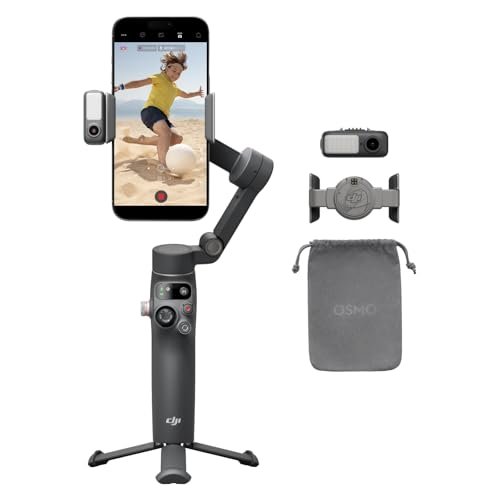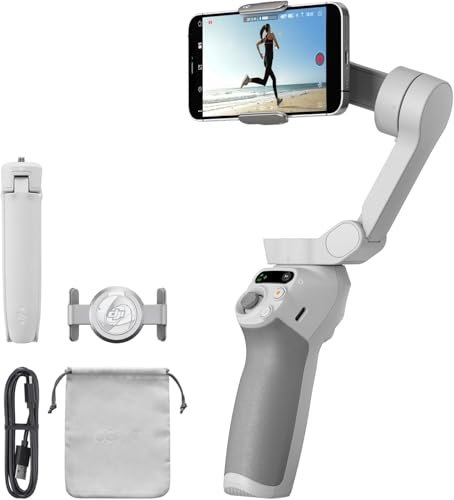So, you’ve got your hands on the mighty Nikon D850. It’s an absolute beast of a camera, renowned for its incredible 45.7MP resolution, superb dynamic range, and fantastic video capabilities, including stunning 4K UHD. But let’s be real: shooting video handheld with such a powerful DSLR can quickly lead to shaky, unprofessional-looking footage. That’s where a good gimbal comes in, transforming your wobbly shots into silky-smooth, cinematic masterpieces.
If you’re on the hunt for the best gimbal for Nikon D850, you’re in the right place. We’re going to dive into what makes a great gimbal pairing for this full-frame powerhouse and highlight our top recommendation that hits all the right notes for D850 users.
Why the Nikon D850 Demands a Good Gimbal
The Nikon D850 is a marvel for both stills and video, offering professional-grade features that truly shine when paired with the right accessories. Its robust build and full-frame sensor mean it’s not exactly a featherweight, especially once you add a lens. This weight, while contributing to stability in still photography, can be a major hurdle for handheld video.
- Nikon D850 FX-Format Digital SLR Camera Body: This camera isn’t just about high-resolution stills; it packs a punch with its 4K Ultra HD video recording and slow-motion capabilities up to 120 FPS at 1080p. To truly leverage these video features and achieve that buttery-smooth, Hollywood-esque look, a reliable gimbal is non-negotiable. Its weight (around 2 lbs / 915g without a lens) combined with a pro lens can quickly push the limits of smaller gimbals.
- Key Specs (Nikon D850 Body):
- Nikon designed back side illuminated (BSI) full frame image sensor
- 45.7 megapixels, outstanding dynamic range
- Up to 9 fps continuous shooting
- 8k & 4k time-lapse movies
- 4K Ultra HD video recording, slow motion up to 120 FPS at 1080p
- Tilting touchscreen, focus shift shooting mode
- Key Specs (Nikon D850 Body):
When choosing a gimbal, the D850’s weight and the specific lens you plan to use are paramount. You need a stabilizer with a robust enough payload capacity to handle the combined weight and ensure balanced movement. This is crucial for unlocking the full potential of your D850’s video prowess.
Key Factors When Choosing a Gimbal for Your D850
Before we unveil our top pick, let’s quickly run through what you should keep an eye out for when selecting a gimbal for your D850:
- Payload Capacity: This is probably the most critical factor. Your gimbal must be able to comfortably support the weight of your D850 plus your heaviest lens. Don’t underestimate this!
- Balance & Setup: How easy is it to balance your camera on the gimbal? Quick-release plates and intuitive adjustments can save you a lot of time and frustration.
- Features: Look for features like different shooting modes (follow, pan follow, FPV), a good battery life, and perhaps a built-in screen or app control.
- Portability: While the D850 isn’t pocket-sized, a more compact and lighter gimbal can be a huge plus for travel and extended shoots.
Our Top Pick: The Best Gimbal for Nikon D850 (and Why!)
Given the D850’s size and weight, you need a gimbal that’s both powerful and practical. Our top recommendation perfectly balances these needs, offering superb stabilization without being overly bulky.
DJI RS 3 Mini, 3-Axis Gimbal Stabilizer for Cameras

The DJI RS 3 Mini is an absolute game-changer for D850 users who crave pro-level stabilization without lugging around a massive rig. What truly makes this gimbal stand out is its incredibly lightweight and compact design, making it a dream for travel or extended shooting sessions. Don’t let its size fool you, though; it packs a punch with its impressive payload capacity, easily handling the D850 with a variety of lenses. It’s designed to give you that buttery-smooth footage with minimal fuss, making it arguably the best gimbal for Nikon D850 in its class for portability and performance.
-
Key Features:
- 795g (1.75lbs) Lightweight and Portable
- Wide-Ranging Compatibility with up to 2 kg (4.4 lbs) payload capacity
- Bluetooth Shutter Control for seamless camera operation
- 3rd-Gen RS Stabilization Algorithm for pro-level image stabilization
- Native Vertical Shooting for social media content
- 1.4″ Full-Color Touchscreen with intuitive UI design
- Requires DJI Ronin app for activation and full functionality
-
Pros:
- Extremely lightweight and travel-friendly
- Robust payload capacity for the D850 and many lenses
- Excellent stabilization performance
- Bluetooth shutter control is a huge convenience
- Native vertical shooting is a bonus for content creators
- User-friendly touchscreen interface
-
Cons:
- Might struggle with very heavy telephoto lenses on the D850
- Requires app activation for full features (common for DJI products)
- Battery life, while good, could be a concern for all-day shoots without backup.
-
User Impressions: Users consistently praise the RS 3 Mini for its surprising strength relative to its size. Many D850 owners find it balances well and delivers incredibly stable footage, noting the ease of setup and the convenience of the Bluetooth shutter. It’s often highlighted as a fantastic option for run-and-gun shooting where a larger gimbal would be too cumbersome.
Essential Gear to Complement Your D850 Gimbal Setup
While the gimbal is the star of the show for smooth video, a couple of other accessories can significantly enhance your experience with the Nikon D850.
MB-D18 Battery Grip for Nikon D850 DSLR Camera, Replacement

When considering the best gimbal for Nikon D850, you also need to think about power and handling. The MB-D18 Battery Grip is a fantastic addition, offering not just extended battery life but also improved ergonomics for vertical shooting. However, it’s vital to remember that adding a battery grip increases the overall weight and changes the center of gravity of your D850 setup. This means you’ll need to re-balance your gimbal, and you must ensure your chosen gimbal (like the DJI RS 3 Mini) can still comfortably handle the increased payload. Always check the combined weight of your D850, lens, and battery grip against your gimbal’s maximum payload capacity.
- Key Features:
- Ergonomic non-slip grip for optimal vertical shooting
- Backup shutter release, main/sub-command dials, function/AF-ON buttons
- Three power supply modes (EN-EL18A, EN-EL15A, or 8 AA batteries) for extended shooting
- Can increase frame rate up to 9 FPS
- 1/4-20 threaded socket for tripod connection
While not a gimbal itself, this grip is an important accessory that directly impacts your gimbal compatibility and performance by altering the camera’s weight and dimensions.
How to Balance Your Nikon D850 on a Gimbal
Once you have your D850 and your chosen gimbal, proper balancing is key to achieving smooth footage and preventing motor strain. It’s a bit of an art, but here are the general steps:
- Mount the Camera: Secure your D850 (with the desired lens and any accessories like the battery grip) onto the quick-release plate.
- Rough Balance: Attach the plate to the gimbal and unlock all axes. Roughly adjust the camera forward/backward, left/right, and up/down until it sits relatively still.
- Perfect Each Axis:
- Tilt Axis (Horizontal): Point the lens straight up or down. If it tips, adjust the camera forward or backward on the plate until it stays put.
- Roll Axis: Tilt the camera to one side. If it rolls, adjust the camera left or right until it balances horizontally.
- Pan Axis: With the other axes balanced, tilt the gimbal handle. If the camera spins, adjust the vertical arm until it remains facing forward.
- Fine-Tune: Make small adjustments. The goal is for the camera to remain stable in any position you leave it, without motors fighting.
Taking the time to balance your best gimbal for Nikon D850 correctly will make a world of difference in your footage quality and gimbal battery life.
Conclusion
Finding the right gimbal for your Nikon D850 is a game-changer for serious videographers. While the D850 is a powerhouse in its own right, pairing it with a capable stabilizer like the DJI RS 3 Mini unlocks its full potential for cinematic storytelling. Always consider your camera’s weight (including lenses and accessories like battery grips) and choose a gimbal with a sufficient payload capacity. With the best gimbal for Nikon D850 in hand, you’re ready to capture stunning, smooth video that truly stands out.
FAQ Section
Q1: Why do I need a gimbal for my Nikon D850?
A1: While the Nikon D850 is excellent for video, it lacks in-body image stabilization. A gimbal provides mechanical stabilization, eliminating shakes and jitters, resulting in incredibly smooth, professional-looking video footage, especially crucial for a camera of its weight and video capabilities.
Q2: What is the most important factor when choosing a gimbal for the D850?
A2: The most critical factor is the gimbal’s payload capacity. The Nikon D850, especially with a lens and potentially a battery grip, can be quite heavy. You must ensure the gimbal can comfortably support the total weight of your camera setup for optimal performance and to prevent motor strain.
Q3: Can the DJI RS 3 Mini handle the Nikon D850?
A3: Yes, the DJI RS 3 Mini has a payload capacity of up to 2 kg (4.4 lbs), which is sufficient for the Nikon D850 with many common lenses. However, always check the combined weight of your specific D850 body, lens, and any accessories (like a battery grip) to ensure it stays within the gimbal’s limits.
Q4: How does a battery grip like the MB-D18 affect gimbal usage?
A4: An MB-D18 battery grip adds significant weight and changes the center of gravity of your Nikon D850. This means you will need to re-balance your gimbal carefully after attaching it, and it will push the gimbal closer to its maximum payload limit. Always factor in the grip’s weight when calculating your total camera setup weight.
Q5: Is it hard to balance the Nikon D850 on a gimbal?
A5: While it takes a little practice, balancing a camera like the D850 on a gimbal becomes straightforward with experience. Most modern gimbals have intuitive adjustments. Taking the time to properly balance ensures the motors aren’t overworked, leading to smoother footage and longer battery life.
Q6: Can I shoot vertical video with my Nikon D850 on a gimbal?
A6: Yes, some gimbals, like the DJI RS 3 Mini, offer native vertical shooting modes. This allows you to quickly reorient your camera to shoot vertical video, perfect for social media platforms like TikTok and Instagram Reels, without needing additional accessories or complex re-rigging.
Q7: What kind of video quality can I expect from the D850 with a gimbal?
A7: With the Nikon D850’s 4K UHD video capabilities and a properly balanced gimbal, you can expect exceptionally sharp, detailed, and incredibly smooth footage. This combination allows for professional-grade cinematic shots, smooth pans, tracking shots, and dynamic movements that would be impossible handheld.


